[ad_1]
Ragnar Kjartansson’s retrospective Epic Waste of Love and Understanding hits Denmark’s Louisiana Museum
The fact that Denmark‘s biggest contemporary art museum is currently hosting a retrospective exhibition of artist Ragnar Kjartansson is simultaneously mind-boggling and almost incredibly banal. On one hand, this is Ragnar Kjartansson, or as he was known back in the day, Rassi Prump (Assy Fartson): the sleazy frontman of a silly naughties pop band Trabant where he came across as a half-naked hipster David Brent. The band were great, sure, but that the lead singer would later be described as one of the “most exciting and significant voices of contemporary art” would have sounded insane just a handful of years ago. At the same time, that statement almost feels like old news by now.
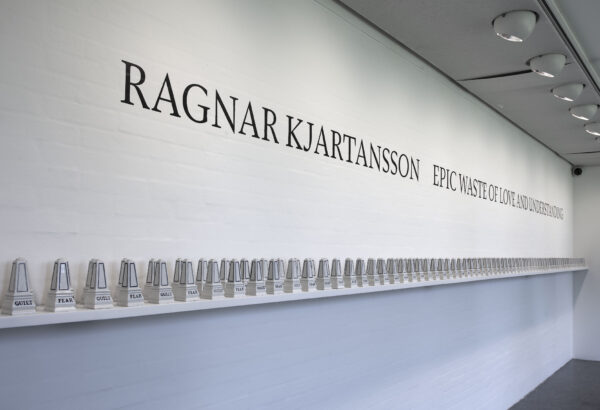
Enter the palace of Raggi Kjartans
Ragnar’s stature on the international stage has been rapidly growing since he became Iceland’s youngest representative at the Venice Biennale in 2009. Ragnar‘s performance at the Biennale, “The End (Venice)” consisted of a tableau where Ragnar painted a picture a day for six months of his friend and fellow artist Páll Haukur Björnsson, who wore a swimsuit and drank beer all day.
The endurance, absurdity and chaos at the core of “The End” are all prevalent elements in the artworks that have since shot Ragnar to international acclaim, not least through “The Visitors” – an hour-long video installation which, in 2019, The Guardian named the best art of the 21st century. Ragnar is a superstar more than deserving of a retrospective at Louisiana.
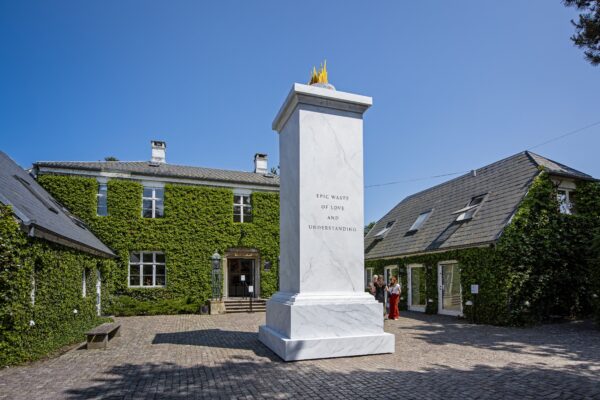
I was ten minutes into the exhibition and it had already given me uncontrollable goosebumps, made me laugh like an idiot and now I was crying in front of a painting of a drunk guy in a swimsuit.
And what an exhibition. First of all, it’s huge. Louisiana has been transformed into the palace of Raggi Kjartans. The main entrance of the museum is a visitor’s first hint of what lays inside, as it’s almost entirely blocked by a palatial column engraved with the exhibition’s title, “EPIC WASTE OF LOVE AND UNDERSTANDING.” Second, it’s the most emotional experience I’ve ever had at an art exhibition, but to explain why, you’ll need to allow a little sidenote for context.
A self-deprecating joke
I‘d spent the evening prior to my Louisiana visit exploring the Nørrebro bar scene with an uncle of mine. My head and heart were, therefore, a touch more tender than they‘d otherwise be. In addition, the quality of our barhop conversations had understandably deteriorated with each hop. At some point, the topic of Ragnar’s exhibition came up and I found myself arguing the embarrassingly pretentious point that Louisiana did not score on the top ten list of European modern art museums. It’s a ridiculous hill to die on and a testament to the deeply embedded minority complex that has afflicted Icelanders for hundreds of years at the mere mention of Denmark. At this point, my family and I had been in Denmark for a couple of weeks and it appeared this hereditary tick was reaching a critical stage when I finally made my way to the exhibition.
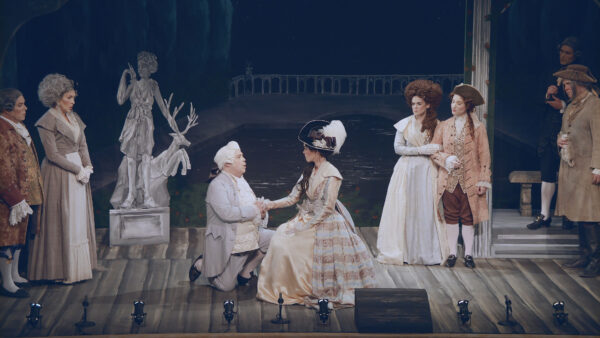
Louisiana, as a building, does nothing to help that feeling of insignificance. As unassuming as the entrance is, even as it’s blocked by Ragnar’s monolithic column, it unveils an absolute marvel of mid-century modernism as you step inside. It’s sprawling and breathtaking, yet so stereotypically Danish that it feels like a self-deprecating joke. Mind you, it’s quite an effortless joke, as it never feels like Louisiana is trying to be anything other than it is. It’s just unavoidable and self-evident and, as such, quite a good analogue for Ragnar’s art. Anyway, on to the exhibition.
A sinister mother-son ritual
The first video installation that greets guests as they enter the main exhibition hall, “Mercy” is an endless loop of Ragnar strumming the guitar and singing the lyric, “Oh why do I keep hurting you?” At first glance, it’s a fairly inconsequential piece in the catalogue of Ragnar’s installations, but I stared transfixed for a few minutes until I noticed that my two-year-old daughter, as hypnotised by the piece as I was, had started duetting with him. The exhibition was instantly given a totally new meaning as I was suddenly seeing it through the eyes of a toddler and there‘s simply no better way to experience Ragnar’s art than with childlike curiosity.
The more sinister “Me and My Mother” was next up. An installation consisting of five screens each playing a video, taken at five-year intervals, in which Ragnar’s mother spits on him repeatedly and for what feels like forever. It’s so ridiculous and saturated in tragicomedy that it verges on being pretentious, but the fact that I was there with my own family, watching a mother-son ritual that will only be repeated a few more times before either of them passes, filled me with such unbearable grief. In order to keep my cool I picked up my two-year-old and hurried to the other side of the hall where I dried my tears as I pretended to be critically evaluating one of the 144 paintings produced during the aforementioned 2009 performance “The End.” I was ten minutes into the exhibition and it had already given me uncontrollable goosebumps, made me laugh like an idiot and now I was crying in front of a painting of a drunk guy in a swimsuit. Great.
A universal exhibition
I regained a modicum of composure when I realised the ridiculousness of showing “Stúka Hitlers” in an international museum. It’s the ruins of a loge made for Hitler in 1941 below a marble slab with the inscription, “Ég hringdi í Helga Björns og hann útvegaði mér stúku Hitlers” (I called Helga Björns and he provided me with Hitler’s booth). The absurdity of the statement is greatly amplified if the audience has an opinion of local Icelandic popstar Helgi Björns. Don’t worry if you don‘t know who he is, I won’t bother explaining. But if you do, there’s nothing to explain.
Thankfully, the rest of the exhibition feels pretty universal and doesn’t rely on the audience having any background information or context. It’s primal and hypnotic, a rollercoaster of absurdity, tragedy and profound joy.
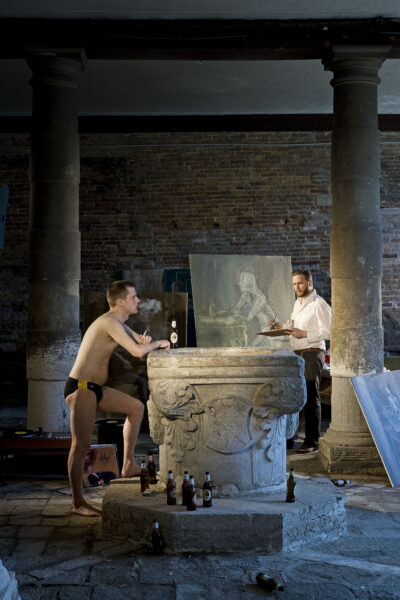
All of Ragnar’s main video installations are here: “A lot of Sorrow,” where rock gods The National play their single “Sorrow” live, continuously and on repeat for six hours; “Bliss,” where opera singers perform the last three minutes of Mozart’s “Marriage of Figaro” live, continuously and on repeat for 12 hours (which n.b. exceeds the opening hours at Louisiana); as well as Ragnar’s seminal piece “The Visitors.”
The Icelandic inferiority complex
The exhibition is nothing short of triumphant. It’s a visual representation of the second law of thermodynamics had thermodynamics been discovered during late-night art school parties.
We don’t stand a chance against our bigger siblings in Scandinavia and have no business trying. We have a genetic inferiority complex that seeps into the everyday details of Icelandic culture.
Ragnar’s art is collaborative in the sense that it represents a whole generation of Icelandic artists and, regardless of the setting, it encapsulates a certain Icelandic psyche. Whether his paintings are created in Venice and exhibited at Louisiana, or whether his art is performed by rock bands, orchestras and opera singers, it all feels like it comes from an after-party at an industrial estate in Grandi. Where artists huddle up and smoke cigarettes for warmth while a damp ocean storm tries its hardest to extinguish their cigarettes and any lingering optimism for the future. Sometimes the only way out is to just have some fun.
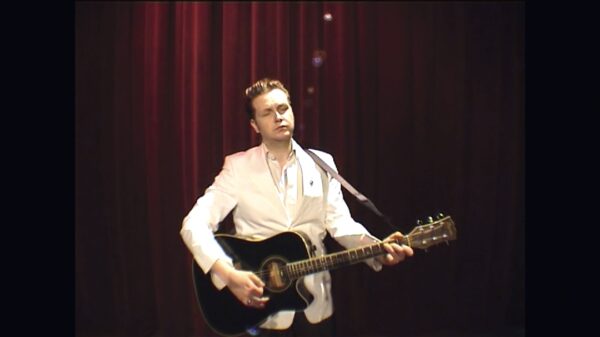
On the way back to the city, emotionally exhausted and with two sleeping children in the backseats of the car, my girlfriend shared a similar impression of the experience. She described Louisiana as having made her feel small and insignificant as a Scandinavian. “We’re all just torfkofaflón (mud hut idiots),” she said referring to Iceland’s standing in the Scandinavian hierarchy. “We don’t stand a chance against our bigger siblings in Scandinavia and have no business trying,” she said.
We have a genetic inferiority complex that seeps into the everyday details of Icelandic culture. How we celebrate holidays, Christmas, birthdays and so on. All the intricate yet incredibly ugly embroidery, the impeccable sugar bowls, this tendency to keep everything ceremonial without extravagance. We inherit these little aspects of our culture that are all there in order to impress the Danish. On the other hand, it feels like we’re appropriating culture. Like we‘ve borrowed everything we associate with Iceland. In reality, though, all we have is nature and foolishness. Our culture consists of wind, hardship and foolishness. And that’s the glory of this exhibition, it’s a celebration of the torfkofaflóns.
[ad_2]
Source link
